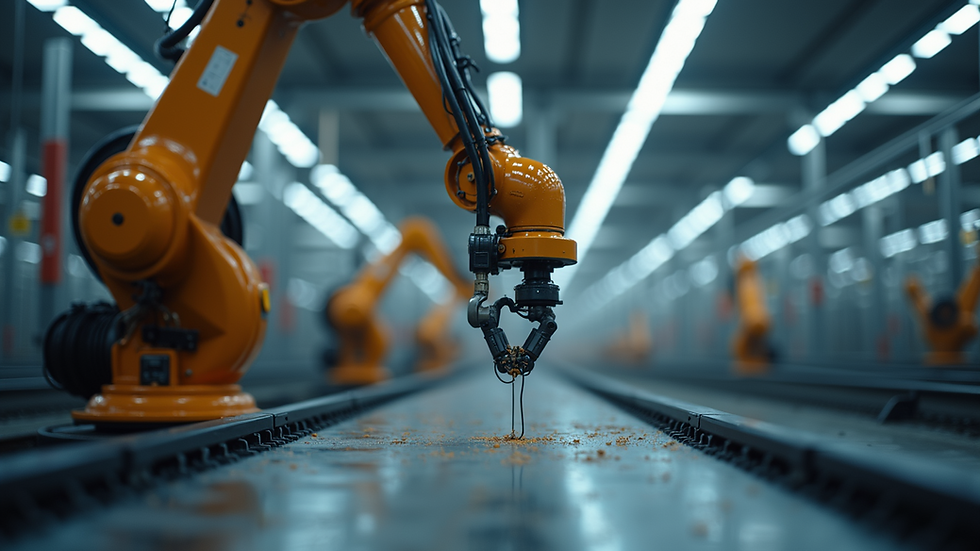Predictive Maintenance for Mining Operations: Improving Equipment Uptime and Reducing Costs
- Emenem Industrial

- Apr 13, 2023
- 3 min read
Updated: Apr 30, 2024
Mining is a crucial industry in South Africa, with the country being one of the leading producers of gold, diamonds, and other minerals. However, mining operations are also notorious for their high equipment maintenance costs and downtime, which can significantly impact profitability. That's where predictive maintenance comes in - a proactive approach to maintenance that uses data analytics and machine learning to predict equipment failures and schedule maintenance before they occur. In this article, we'll explore the benefits of predictive maintenance for mining operations and how it can be implemented effectively.

Benefits of Predictive Maintenance for Mining Operations
Reduced Equipment Downtime: Predictive maintenance helps mining companies to reduce unplanned equipment downtime by identifying potential issues before they cause a breakdown. This leads to increased equipment uptime, improved production output, and increased profitability.
Lower Maintenance Costs: Predictive maintenance helps to reduce maintenance costs by allowing mining companies to schedule maintenance when it is needed rather than on a fixed schedule. This means that maintenance is only performed when necessary, reducing costs associated with unnecessary repairs and replacements.
Improved Safety: Predictive maintenance can help mining companies to improve safety by identifying potential equipment failures that could cause accidents or injury to workers. By proactively scheduling maintenance, mining companies can prevent accidents and ensure the safety of their workers.
Implementing a Predictive Maintenance System for Mining Operations
To implement a predictive maintenance system for mining operations, the following steps are typically involved:
Data Collection: The first step in implementing a predictive maintenance system is to collect data from equipment sensors and other sources. This data can include equipment performance data, sensor data, maintenance logs, and more. Data collection can be done manually or through automated sensors.
Data Analysis: Once data is collected, it needs to be analyzed to identify patterns and anomalies that could indicate potential equipment failures. Machine learning algorithms can be used to analyze data and make predictions based on historical data.
Predictive Maintenance Plan: Based on the data analysis, a predictive maintenance plan is developed, which outlines when and how maintenance should be performed to prevent equipment failures. This plan can be integrated into existing maintenance processes or implemented as a separate process.
Implementation: Once the predictive maintenance plan is developed, it needs to be implemented in the mining operation. This involves training employees on the new process, integrating the plan into existing maintenance processes, and monitoring the system for effectiveness.
Tips for Effective Predictive Maintenance in Mining Operations
To ensure the effectiveness of a predictive maintenance system in mining operations, the following best practices should be followed:
Define Clear Objectives: Before implementing a predictive maintenance system, it's important to define clear objectives and requirements. This includes identifying which equipment should be monitored, which data sources should be used, and what metrics should be tracked.
Plan for Scalability: Predictive maintenance systems should be designed with scalability in mind to accommodate future growth and changes in equipment.
Conduct Thorough Testing: Before implementing a predictive maintenance system, it's important to conduct thorough testing to ensure that it is effective and reliable.
Use Standardized Communication Protocols: To ensure that data can be easily shared and analyzed across different systems, standardized communication protocols should be used.
Ensure System Security: Predictive maintenance systems can involve sensitive data, so it's important to ensure that the system is secure and that data is protected from unauthorized access.
Provide Comprehensive Training: To ensure that employees are using the system effectively, comprehensive training should be provided on the new process and tools.
In conclusion, predictive maintenance is a powerful tool for mining companies to improve equipment uptime, reduce maintenance costs, and ensure the safety of their workers. By implementing a predictive maintenance system, mining companies can move from reactive maintenance to proactive maintenance, leading to significant cost savings, increased equipment uptime, and improved safety. With the right tools and processes in place, mining companies in South Africa can leverage the power of predictive maintenance to stay competitive in today's market.
In need of an industrial solution?





Comments